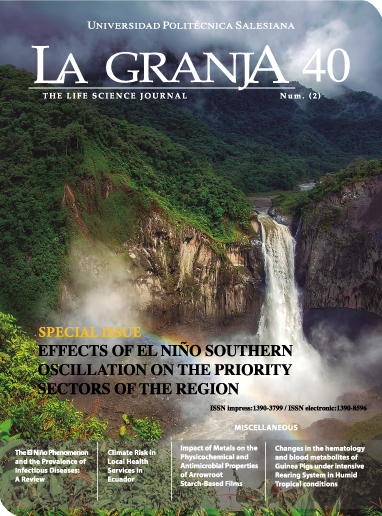Impact on the incorporation of metals in physicochemical and antimicrobial properties in films based on arrowroot starcha
Main Article Content
Abstract
Article Details

This work is licensed under a Creative Commons Attribution-NonCommercial-ShareAlike 4.0 International License.
Universidad Politécnica Salesiana of Ecuador preserves the copyrights of the published works and will favor the reuse of the works. The works are published in the electronic edition of the journal under a Creative Commons Attribution/Noncommercial-No Derivative Works 3.0 Ecuador license: works can be copied, used, disseminated, transmitted and publicly displayed.
The undersigned author partially transfers the copyrights of this work to Universidad Politécnica Salesiana of Ecuador for the printed edition.
References
Akter, N. y col. (2012). «Fabrication and mechanical characterization of biodegradable and synthetic polymeric films: Effect of gamma radiation». En: Radiation Physics and Chemistry 81.8, 995-998. Online: https://n9.cl/zowbn.
Arfat, Y. A. y col. (2017). «Deciphering the potential of guar gum/Ag-Cu nanocomposite films as na active food packaging material». En: Carbohydrate Polymers 157, 65-71. Online: https://bit.ly/4f5o8fw.
Brito, G. y col. (2011). «Biopolímeros, polímeros biodegradáveis e polímeros verdes». En: Revista electrônica de materiais e Processos 6.2, 127-139. Online: https://n9.cl/zdrtp.
Cheviron, P., F. Gouanvé y E. Espuche (2014). «Green synthesis of colloid silver nanoparticles and resulting biodegradable starch/silver nanocomposites». En: Carbohydrate polymers 108, 291-298. Online: https://n9.cl/kzlyo.
Cruz, T. y col. (2020). «Síntese e caracterização de complexos de cobalto (II) com ligantes orgânicos e avaliação antimicrobiana». En: UNESUM- Ciencias. Revista Científica Multidisciplinaria 3.1, 177-190. Online: https://n9.cl/b7bxp.
Farias, S. y col. (2016). «Biopolímeros: uma alternativa para promoção do desenvolvimento sustentável». En: Revista Geonorte 7.26, 61-77. Online: https://n9.cl/82q3d.
Fathi, N., H. Almasi y M. Pirouzifard (2018). «Effect of ultraviolet radiation on morphological and physicochemical properties of sesame protein isolate based edible films». En: Food Hydrocolloids 85, 136-143. Online: https://n9.cl/40ie5.
Gómez-Estaca, J. y col. (2010). «Biodegradable gelatin–chitosan films incorporated with essential oils as antimicrobial agents for fish preservation». En: Food microbiology 27.7, 889-896. Online: https://n9.cl/5kolp.
Haider, T. y col. (2019). «Plastics of the future? The impact of biodegradable polymers on the environment and on society». En: Angewandte Chemie International Edition 58.1, 50-62. Online: https://n9.cl/bizj0q.
Hosseini, S. y col. (2015). «Bio-based composite edible films containing Origanum vulgare L. essential oil». En: Industrial Crops and products 67, 403-413. Online: https://n9.cl/trdap.
Issa, A., S. Ibrahim y R. Tahergorabi (2017). «Impact of sweet potato starch-based nanocompo site films activated with thyme essential oil on the shelf-life of baby spinach leaves». En: Foods 6.6, e43. Online: https://n9.cl/hdi230.
Jafarzadeh, S. y col. (2017). «Fabrication and characterization of novel semolina-based antimicrobial films derived from the combination of ZnO nanorods and nanokaolin». En: Journal of food science and technology 54, 105-113. Online: https://n9.cl/a6gdj.
Kubowicz, S. y A. Booth (2017). «Biodegradability of plastics: challenges and misconceptions». En: Environmental Science y Technology 51, 12058-12060. Online: https://n9.cl/lxpq5.
Madineni, M. y col. (2012). «Morphological, structural, and functional properties of maranta (Maranta arundinacea L) starch». En: Food Science and Biotechnology 21, 747-752. Online: https://n9.cl/g5r9a.
Martucci, J. F. y R. A. Ruseckaite (2009). «Tensile Properties, Barrier Properties, and Biodegradation in Soil of Compression—Molded Gelatin- Dialdehyde Starch Films». En: Journal of Applied Polymer Science 112.4, 2166-2178. Online: https://bit.ly/3zAujYH.
Nogueira, G., F. Fakhouri y R. de Oliveira (2018). «Extraction and characterization of arrowroot (Maranta arundinaceae L.) starch and its application in edible films». En: Carbohydrate polymers 186, 64-72. Online: https://n9.cl/r8jigj.
Nor Adilah, A. y col. (2018). «Utilization of mango peel extracts on the biodegradable films for active packaging». En: Food packaging and shelf life 16, 1-7. Online: https://n9.cl/2mr6d.
Olivatto, G. y col. (2018). «Microplásticos: Contaminantes de preocupação global no Antropoceno». En: Revista Virtual de Química 10.6, 1968-1989. Online: https://n9.cl/mdi0a.
Pagno, C. H. y col. (2015). «Development of active biofilms of quinoa (Chenopodium quinoa W.) starch containing gold nanoparticles and evaluation of antimicrobial activity». En: Food Chemistry 173, 755-76. Online: https://bit.ly/3XUQByh.
Pitt, F., D. Boing y A. Barros (2011). «Desenvolvimento histórico, científico e tecnológico de polímeros sintéticos e de fontes renováveis». En: Revista da UNIFEBE 1. Online: https://n9.cl/bcynx.
Santos, L. S. y col. (2021). «Ethanolic extract from Capsicum chinense Jacq. ripe fruits: phenolic compounds, antioxidant activity and development of biodegradable films». En: Food Science and Technology 41.2, 497–504. Online: https://bit.ly/3LfRJoJ.
Saral Sarojini, K., M. Indumathi y G. Rajara- jeswari (2019). «Mahua oil-based polyurethane/chitosan/nano ZnO composite films for biodegradable food packaging applications». En: International journal of biological macromolecules 124, 163-174. Online: https://n9.cl/8ljno.
Shafiei Shafiei, S. y col. (2021). «Suppression of Xanthomonas oryzae pv. oryzae biofilm formation by Acacia mangium methanol leaf extract». En: Brazilian Journal of Biology 81.1, 11-17. Online: https://n9.cl/q0mvb2.
Sobral, P., J. Frias y J. Martins (2011). «Microplásticos nos oceanos-um problema sem fim à vista». En: Ecologia 3, 12-21. Online: https://n9.cl/7g4m9.
Valadares, A. y col. (2020). «Incorporation of essential oils from Piper aduncum into films made from arrowroot starch: effects on their physicochemical properties and antifungal activity». En: Química Nova 43.6, 729-737. Online: https://n9.cl/3s78e1.
Wang, H. y col. (2010). «Preparation of ceriumdoped TiO2 film on 304 stainless steel and its bactericidal effect in the presence of sulfatereducing bacteria (SRB)». En: Materials chemistry and physics 124.1, 791-794. Online: https://n9.cl/w6v2b.
Yin, R. y col. (2009). «Preparation and characterization of novel gelatin/cerium (III) fiber with antibacterial activity». En: Materials Letters 63.15, 1335-1337. Online: https://n9.cl/bq9es.
Youssef, H. y col. (2019). «Antimicrobial packaging film based on biodegradable CMC/PVA-zeolite doped with noble metal cations». En: Food Packaging and Shelf Life 22, 100378. Online: https://n9.cl/gs7ep.

